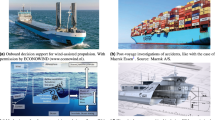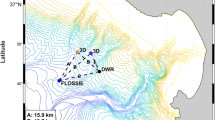Sumamry
Simultaneous wave measurements were made in coastal waters with three instruments; an accelerometer buoy and two ship-borne wave recorders mounted at different depths on two different types of ship. A comparison was made between the wave energies obtained and calibration curves were prepared for both ship-borne wave recorders to allow for the falling off in response at high frequencies. These show that the effective depth to be used in the exponential term is much bigger than the actual depth. In the experiment described here the values were found to be 2.25 d and 3.0 d.
Zusammenfassung
Mit drei verschiedenen Instrumenten wurden gleichzeitig Wellenmessungen in Küstengewässern ausgeführt. Dabei wurde ein in einer Boje untergebrachter Beschleunigungsmesser benutzt und zweiship-borne wave recorders, die von zwei verschiedenen Schiffstypen aus in verschiedenen Tiefen ausgelegt wurden. Die so aufgezeichneten Wellenenergien wurden miteinander verglichen, und für beideship-borne wave recorders wurden die Eichkurven ermittelt, um das Fallen der Anzeige bei hohen Frequenzen berücksichtigen zu können. Aus diesen Eichkurven geht hervor, daß die Effektiv-Tiefe, die für das Exponentialglied zu benutzen ist, viel größer ist als die tatsächliche Tiefe. In dem hier beschriebenen Experiment wurden die Multiplikationsfaktoren auf 2,25d und 3,0d festgestellt.
Résumé
A l'aide de trois instruments on a effectué des enregistrements simultanés de vagues en eaux côtières. Dans ce but, on s'est servi d'un accéléromètre monté dans une bouée et de deuxship-borne wave recorders installés à bord de deux types différents de bâtiment et lancés à différentes profondeurs. Les énergies de vagues enregistrées avec ces deux instruments sont comparées les unes aux autres. Puis, on établie des courbes d'étalonnage afin de pouvoir obtenir le taux de diminution des valeurs indiquées dans le secteur de grandes fréquences. Les courbes d'étalonnage montrent nettement que la profondeur effective (effective depth) qui est à utiliser pour le terme exponentiel, doit être plus grande que la profondeur réelle. L'essai, décrit dans le travail actuel, permet de constater que les multiplicateurs s'en élèvent à 2,25d et à 3,0d. *** DIRECT SUPPORT *** A0167016 00002
Similar content being viewed by others
References
Cartwright, D. E., 1961: The use of directional spectra in studying the output of a wave recorder on a moving ship. Conference on Ocean Wave Spectra, Easton, Maryland, May 1–4, 1961.
Darbyshire, J., 1959a: A further investigation of wind generated waves. Dt. Hydrogr. Z.12, 1.
Darbyshire, J., 1959b: The spectra of coastal waves. Dt. Hydrogr. Z.12, 153.
Darbyshire, Mollie, 1958: Waves in the Irish Sea. Dock and Harbour Authority,39, 245.
Darbyshire, Mollie, 1960: Waves in the North Sea. Dock and Harbour Authority,41, 225.
Longuet-Higgins, M. S., 1946: Measurement of sea conditions by the motion of a floating buoy. Detection of predominant groups of swell. Admiralty Research Lab. Report 103.40/N5.
Neumann, G., and W. J. Pierson, Jr., 1957: A detailed comparison of theoretical wave spectra and wave forecasting methods. Dt. Hydrogr. Z.10, 134.
Tucker, M. J., 1956a: The N.I.O. wave analyser. Proceedings of 1st Conference on Coastal Engineering Instruments at Berkely, California, 31 Oct.–2 Nov. 1955, 129.
Tucker, M. J., 1956b: A ship-borne wave recorder. Trans. Inst. Nav. Arch. London,98, 236.
Rights and permissions
About this article
Cite this article
Darbyshire, M. A method of calibration of ship-borne wave recorders. Deutsche Hydrographische Zeitschrift 14, 56–63 (1961). https://doi.org/10.1007/BF02233298
Received:
Published:
Issue Date:
DOI: https://doi.org/10.1007/BF02233298




